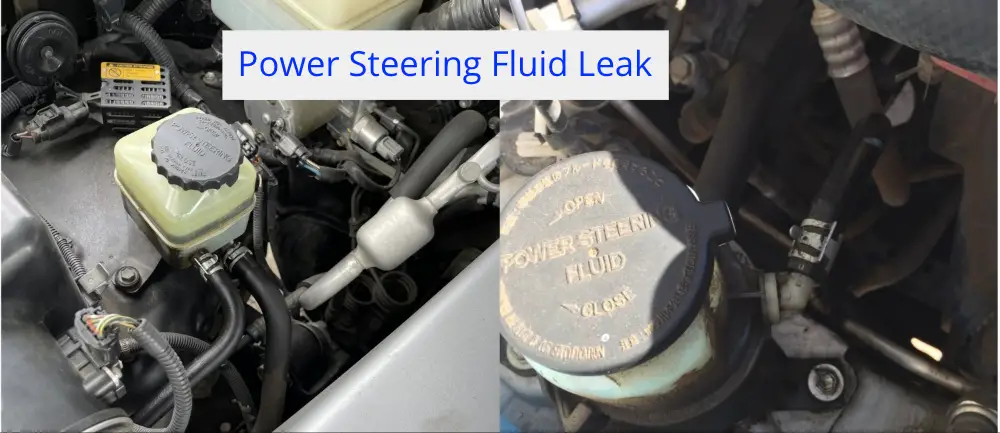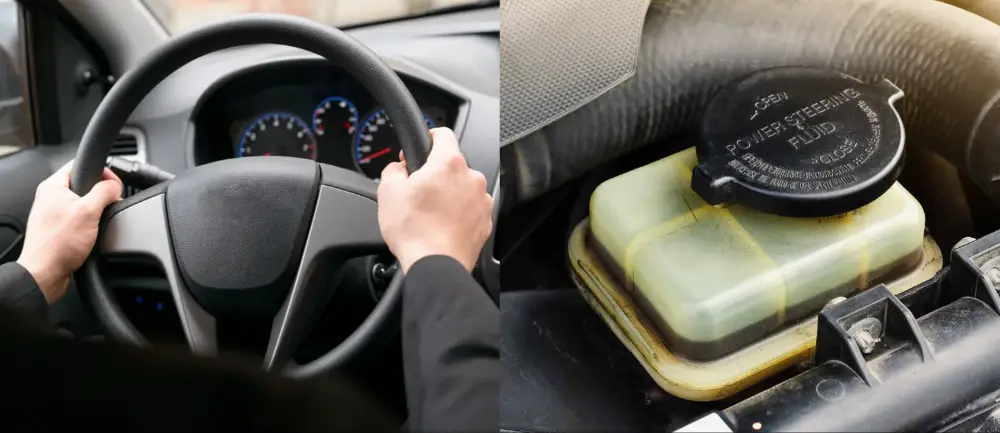
With most cars having power steering, a power steering fluid leak can be disastrous, especially while driving.
Not having power steering can damage the steering column and other areas of the steering system – but what causes power steering fluid to leak, and how can you fix it?
The common causes of most power steering fluid leaks are using the wrong power steering fluid, a leak in the power steering rack, if the power steering fluid tank is too full, and either a leaking power steering pump or leaks in the power steering hoses.
To better understand these potential causes for power steering fluid leaks and how they can be fixed, let’s look at them in more detail and understand the power steering system itself and what symptoms you can look out for to identify a power steering leak.
How Does Power Steering Work?
Before the advent of power steering, most cars had manual steering, which required serious muscle power to turn the wheel, especially on heavy vehicles like the big V8s and pickups. This meant some folks had to spend time in the gym to build their upper body strength.
Believe it or not, the first power steering system fitted to a car was done in 1951 with a Chrysler Imperial. This allowed easier control of the steering column using hydraulics instead of muscle power.
This system also improved steering response time and gave the driver greater directional control over the car in tight turns or when traveling at speed.
Hydraulic power steering or power assist uses fluid to apply torque to the steering mechanism when you turn the wheel, and this fluid is powered by a pump connected to the engine. Sensors in the power assist system detects how much fluid is required to flow to the wheels depending on how hard you turn.
Electric power steering is found mostly in high-end cars and uses an electronic system instead of hydraulics to control the steering. While this is more expensive, it has a lower risk of failure as no hydraulic components are involved.
Now, let’s look at the common causes of power steering fluid leaks and how to fix them.
How To Check If Your Car Has A Power Steering Fluid Leak

The most common symptom is seeing fluid on the floor underneath the car. This will happen if one of the hoses leaks or the pump itself has failed or cracked.
You can verify this by checking whether fluid is still in the power steering reservoir; if it is empty or lower than usual, you have a power steering fluid leak.
Another symptom of a power steering fluid leak is when the steering wheel feels more difficult to turn and requires more power than usual from you to steer. If this happens, check for fluid leaks under the car and fluid levels in the reservoir.
If you don’t know where this is, take your car to a service station and ask them to help you check it. While you can drive a car without power steering, it can be dangerous as you won’t have the same response and control as you would normally.
Here are the most common causes of the power steering fluid leaks and how to fix them:
1. Not Using The Right Power Steering Fluid Can Cause A Leak
While hydraulic power steering systems are mostly the same, the fluid required for each car may differ depending on the car’s performance, weight, and engine power, so you may need to use a specific power steering fluid in your vehicle, which may not work in another car.
Using the wrong power steering fluid means that the fluid’s viscosity may not be suited to your car’s power steering system and can cause too much pressure resulting in a leak in the system.
Not only that but using a power steering fluid not designed for your car can also damage power steering components.
Solution
Your car instruction manual will tell you which power steering fluid you need, and if you don’t have the manual or can’t find it, you can check this on your vehicle manufacturer’s website or simply by calling a dealer.
To fix this issue, drain the fluid from the system and refill it with the correct fluid. If you cannot do this yourself, it may mean a short and relatively inexpensive trip to your mechanic.
While this may cost a few dollars, replacing or repairing a damaged steering system will be much more.
2. You Could Have A Leak In The Power Steering Rack
Another common cause of power steering fluid leaks is when there is a rupture in the power steering rack.
This will cause the hydrualic fluid to leak out; again, you will see evidence of this on the ground or when driving.
Also known as the rack and pinion steering rack, this part of the car is exposed to road dirt and debris, and this will cause wear and tear of the seals and shaft over time.
As a result, the power steering fluid will leak when seals fail, or the shaft is damaged.
Solution
The proper (and only) way to repair this issue is to replace the power steering rack completely.
Whether you opt for a new or reconditioned one will depend on your budget, but once the rack is compromised, there is no quick fix, and replacement is the only option.
3. If The Power Steering Tank Is Too Full, It Can Leak
Remember that you are dealing with a hydraulic system, and the pressure required to turn the wheels is significant.
If you overfill the reservoir, this creates too much pressure within the system and will cause the seal in the steering rack to ‘blow up as the excess pressure is exerted.
Each reservoir has a maximum line that indicates where you can fill the reservoir without risk, and while it may seem like more is better, this is not the case with power steering fluid.
Solution
This is not a costly or timely fix and simply requires the removal of excess fluid from the reservoir using a syringe, cloth, or even a baster – yes, like you’d use for a turkey- to soak up and remove the fluid until the level is below the maximum fill line.
4. The Power Steering Pump Can Leak Or Fail
With hydraulic components, the continued pressure causes wear and tear with the gaskets and seals in the pump, and over time, the pump itself could also fail.
Where the pump gasket is worn, fluid will leak out under pressure, and you will see this under the car or experience a loss of power steering when driving.
The pump is responsible for moving the fluid to the wheels when required, and if the seal on the pump shaft fails, this will cause the power steering fluid to leak. The pump casing can also break as the gasket becomes loose over time, leading to a fluid leak.
Solution
As with the power steering rack, you would need to replace the power steering pump completely, and then once that is done, check that there are no other leaks as the pressure is restored with the new pump.
A mechanic best does this, and they will check the system and bleed it to remove any air once the power steering fluid has been added after the replacement pump is installed.
This repair should not be too costly, but not having it done is dangerous and could result in more damage to the steering system.
5. Worn Or Loose Power Steering Hoses Can Cause A Fluid Leak
The first place to check if you suspect you have a power steering fluid leak is the hoses. There are two hoses, one connected to the reservoir and one connected to the pump. This is a very common cause of leaks in most hydraulic systems.
The return hose connects the reservoir to the gearbox, and the pressure hose links the steering pump to the steering box. A loose seal is often the culprit, but in some cases, the hoses themselves have worn away and become brittle.
When this happens, they can no longer withstand the internal fluid pressure flowing through them, and leaks may occur at the seals or from the hose itself, where the hose wall has perished and ruptured, causing the fluid to leak out.
Solution
If this is a seal failure, you can tighten the seals or use Teflon tape in the seal thread to secure and stop the leak. If the hoses leak, you can temporarily seal them using tape, but this should only be until you can replace them.
It’s also advisable to replace both the pressure and return hose simultaneously so you can have optimum pressure through the system again. This is not a costly repair and can be done relatively quickly, within a few hours.
Once completed, the mechanic will bleed the system to remove residual air, and your power steering system will be restored for easy driving!
I found this video helpful:
Conclusion
No power steering system will last forever, and with hydraulic systems, the older the car gets, the more wear and tear you will have.
Fortunately, diagnosing and fixing power steering fluid leaks is fairly straightforward and not that expensive unless the power steering rack needs replacing.
Suppose you notice fluid under the car or your steering is getting heavier. In that case, this is almost certainly an indication of a power steering fluid leak, and you should have it checked immediately to avoid more potentially costly damage.
